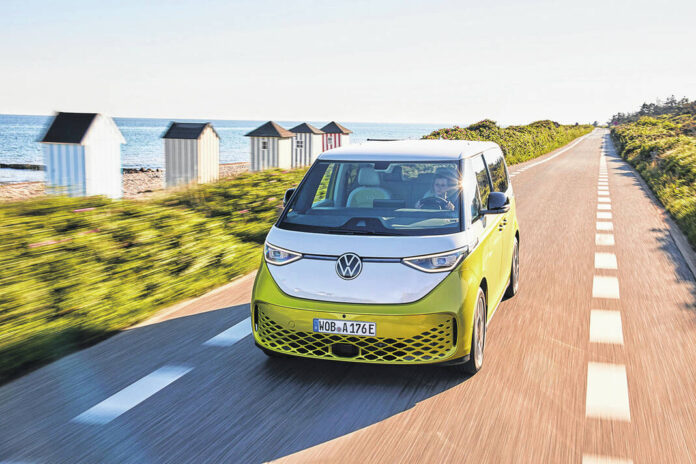Volkswagen has been teasing us with a new version of their iconic Type 2 Microbus for 22 years. The first concept debuted at the North American International Auto Show in Detroit in 2001 and was powered by a gas engine. Then, in 2011, the company trotted out another Microbus concept vehicle named the Bulli, followed by the Budd-E in 2016. The following year, Volkswagen revealed the electric ID.Buzz, although we could be forgiven for thinking this was little more than wishful thinking on Volkswagen’s part.
But it wasn’t and it isn’t, for the new 2023 Volkswagen ID.Buzz is finally on sale – but only in Europe. Nevertheless, Volkswagen brought one along to the Amelia Island Concours d’Elegance in Florida, where it took in some tropical sunshine along with a class of classic Type 2 Microbuses.
The ID.Buzz they brought along was a short-wheelbase model with two rows of seats and an overall length of 185.5 inches. It has one motor that funnels its power to the rear wheels.
But that’s not the Buzz that America will be getting. Our model will be larger. Still, piloting the smaller Buzz was the chance to see what this newest battery electric VW is all about.
The 2023 Volkswagen ID.Buzz is built using the company’s Modular Electric Drive (MEB) architecture that’s also used for the Audi e-tron and the VW ID.4 crossovers. But the ID.Buzz differs from its cousins due to its design charisma; it’s the only vehicle in Volkswagen’s ID electric vehicle lineup with any semblance of personality, one that riffs on the buses of decades past, rather than the eminently forgettable Volkswagen Routan.
The test vehicle was yellow and white, which did much to activate the design Wayback Machine. But it’s the fact that the ID.Buzz is electric, and its batteries and mechanicals are underneath the vehicle, rather than in front, that allow designers to fit some semblance of a flat front – just like the original. But the Buzz’s nose is sloped, not only for aerodynamic efficiency but also to meet crash regulations. Designers also placed the driver behind the front axle, not over it, for similar reasons. And the Buzz wears the lighting signature of its ID compatriots, not the round headlights you might expect.
Walk around to the rear of the Buzz and, aside from the vents on the rear roof pillar, there’s little to suggest any heritage here. In fact, the rear’s square shape helps with its aerodynamics and cargo hauling ability. In fact, the rear cargo hold can schlep 40 cubic feet of lifestyle debris, 78 cubic feet with the second row folded, and the roof can carry an additional 220 pounds.
At 78 inches wide, the cabin feels positively cavernous, a feeling enhanced by its large windows, low beltline and panoramic sunroof. It is also helped by its vibrant interior, which continues the exterior’s yellow and white color scheme inside, and is far removed from Volkswagen’s typically gloomy interiors. And its thoughtful design touches include passenger doors with built-in shelves and a USB-C plug for charging smartphones, as well as a wireless charging pad. A 10-inch infotainment touchscreen is standard, a 12-inch unit is optional.
Overall, it feels fun, something you can’t typically say about minivans.
Like the original Type 2, the Buzz comes with rear-wheel drive courtesy of a solitary rear electric motor that generates 201 horsepower and 229 pound-feet of torque and a 0-62 mph time of 10.2 seconds. The top speed is limited to 90 mph. Volkswagen states the ID.Buzz delivers as much as 264 miles of range on the European WLTP cycle, which runs about 22% higher than the EPA test cycle. A full recharge takes 7.5 hours using a Level 2 charger; recharging from 5% to 80% takes a half-hour using a DC Fast Charger.
Given those numbers, it’s clear that the ID.Buzz is no speed demon, but neither was the Type 2, or its successors such as the Vanagon. But it is very, very refined.
There’s an even keel to the ID.Buzz’s demeanor, one that lacks the sharp burst of acceleration so typical of EVs. But that’s in keeping with its character. For anyone accustomed to racket generated by the Type 2’s engine, the all-encompassing silence will prove a revelation. Its massive interior makes the vehicle feel larger than it is, a feeling that will be punctured once you drive it. It’s then that the ID.Buzz reveals its agreeable, easy-to-drive nature. With a 36-foot turning radius, it’s easy to maneuver in tight urban areas.
And when hitting the highway, you’ll find it has a comfortably compliant ride without excess ride motions. It always remains controllable. As in other EVs, the batteries are mounted down low in the center of the vehicle, lending the ID.Buzz a secure, planted feel when cornering. You won’t hear any wind noise, although you’ll notice a faint hint of road noise.
Volkswagen is expected to reveal the three-row, long-wheelbase ID.Buzz this summer, after which it will go on sale for the 2024 model year. That’s when it will arrive stateside, as we won’t be getting the shorter variant.
Nevertheless, the 2023 Volkswagen ID.Buzz manages to accomplish something that has long eluded minivan marketers: it makes it an object of desire. It could even become a status symbol, the ultimate cul-de-sac driveway accessory.







